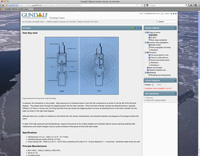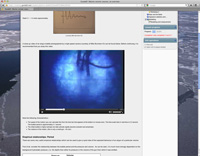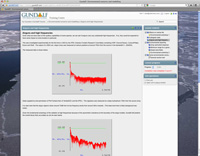
Course Bookings
Please note that we are currently not taking new bookings whilst the course is being updated.
Gundalf Course Online
Gundalf and the Marine Seismic Source:
Modelling, Deployment, Optimisation, and Environmental Impact of Airgun Arrays
By Professor Les Hatton, Oakwood Computing Associates Ltd
This course is designed to give a detailed overview of marine seismic airgun design with hands-on access to Gundalf, a state of the art modelling system to help teach the fundamentals using numerous workshops.
Who is the course for?
Acquisition and processing geophysicists involved with marine seismic source signatures and their influence on seismic data quality.
Any pre-requisites?
Some prior background in exploration geophysics is useful either in the field or in seismic data processing.
Course Logistics

State-of-the-art Learning Management System
The course is given within a sophisticated online environment, enabling users to learn on-demand, track and save their progress, log their scores, and complete tests and other workshops in their own time. The course supports the majority of leading web browsers*.

Rich Media Content
As well as images, graphs and diagrams, the course contains video and audio examples to further aid understanding.

Hands-on use of the Gundalf Software
Participants will have access to a special teaching-version of the Gundalf airgun array modelling system to help teach the fundamentals using numerous workshops and working examples.
Certification
As with the physical version, participants will receive a personalised course certificate for successful completion.
Please contact us for more information and bookings.Course Content
The course is based around the original reference [1])(See Bibliography) updated to modern acquisition practices and consists of the following sections.
-
MARINE SEISMIC SOURCES: AN OVERVIEW
This section gives an overview of the development of marine seismic sources from their first appearance to modern day deployment. It covers types of source, acoustic wave propagation in water, bubble motion, the ghost, near and far fields, signature statistics and their measurement and computer modelling of airgun signatures.
-
ARRAY HANDLING WITH GUNDALF
This section is an introduction with numerous workshops to the practical results of modelling the physics described in the previous section using Gundalf.
-
DIRECTIVITY AND INTERACTION
This section describes the essence of array directivity and airgun interaction in detail with many practical examples, again illustrated with practical workshops with Gundalf. The principles of interaction are described in terms of notional sources and the physics of gun clusters is illustrated again with numerous workshops. Energy interaction is also described here.
-
PRACTICAL DESIGN ISSUES
In this section, array stability, the shot effect, gun synchronisation, instrument response and centres of gravity of an array are explored and described with practical examples.
-
DROP-OUT ANALYSIS
Practical drop-out criteria are covered and demonstrated using a series of workshops in Gundalf.
-
OPTIMISING ARRAYS
Array optimisation for specific geophysical targets such as sub-basalt shooting are covered using Gundalf's unique optimisation modes. A series of workshops leads the attendee through various forms of constrained optimisation of airgun arrays. The relationship with seismic data processing is also described.
-
ENVIRONMENTAL ISSUES
The potential impact of airgun arrays on marine life is discussed in detail including mitigation procedures.
Bibliography
- G.E. Parkes and L. Hatton, The Marine Seismic Source, 1st edition, van Reidel, ISBN 90-277-2228-5 (1986).
- L. Hatton, M.H. Worthington and J. Makin, Seismic Data Processing: theory and practice, 1st edition, Blackwell, ISBN 0-632-01374-5(1986).
- A.M. Ziolkowski., ‘A method for calculating the output pressure waveform from an airgun’, Geo. J. Royal Ast..Soc. 21 137-161. (1970)
- S. Vaage, S. Strandness and T. Utheim, ‘Signatures from single airguns’, Geophysical Prospecting. 31 87-97. (1984)
- A.M. Ziolkowski, G.E. Parkes, L. Hatton and T. Haugland, ‘The signature of an airgun array: computation from near-field measurements including interactions’, Geophysics. 47 1413-1421 (1982)
- G.E. Parkes, A.M. Ziolkowski, L. Hatton and T. Haugland, ‘The signature of an airgun array: computation from near-field measurements – practical considerations’, Geophysics. 49 105-111 (1984)
- R.M. Laws, G.E. Parkes, and L. Hatton, ‘Energy-interaction: The long-range interaction of seismic sources’, Geophysical Prospecting. 36, 333-348 (1988)
- R.M. Laws, L. Hatton and M. Haartsen, ‘Computer modelling of clustered airguns’, Geophysical Prospecting First Break. 8(9), 331-338 (1990)
- L. Hatton, ‘Incorporating marine mammal hearing sensitivity into a high-grade airgun modelling package (extended abstract)’, PETEX 2004, abstract available at http://www.leshatton.org/PETEX04.html
- L. Hatton, ‘Gundalf™ – an airgun array modelling package’, http://www.gundalf.com/ (2002-)
- J.R. Fricke, J.M. D.H. Davis and Reed “A standard quantitative calibration procedure for marine seismic sources”, Geophysics, 50(10), p. 1528-1532 (1985)
- L. Hatton, ‘Commentary on two airgun videos’, http://www.leshatton.org/two_airgun_videos.html, (2007)
- W.J. Richardson, C.R. Greene, C.I. Malme and D.H. Thomson, Marine Mammals and Noise, 1st edition, Academic Press, ISBN 0-12-588441-9 (1995)
- L. Hatton, “The broadband acoustic output of marine seismic airgun sources”, Proceedings of the Institute of Acoustics, Underwater Noise, 2008, Southampton, England (2008).

